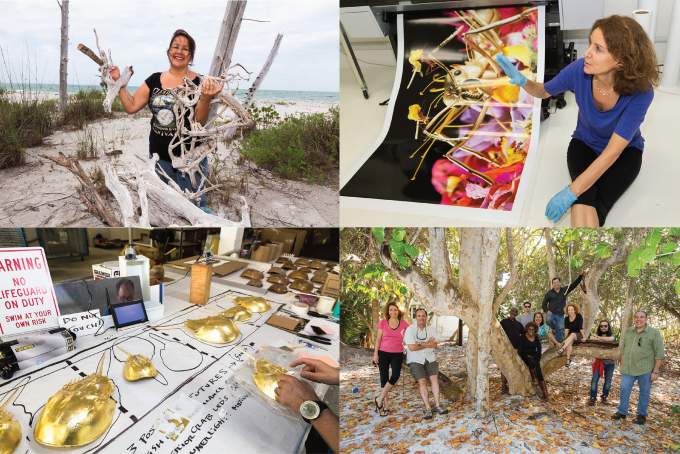
Photos: Sage Sohier
THE CONCLUSION OF RAUSCHENBERG RESIDENCY 11
During his residency, Tijuana-based artist Marcos Ramirez printed the front page of a different international newspaper each day for thirty-three days and screen-printed imagery that he had photographed around Captiva. Later, he will add text to create a personal journal that is juxtaposed against his worldview. Inspired by Rauschenberg’s legacy of printmaking and collage, Ramirez chose to integrate similar techniques into his work during the residency.
Other artists in Residency 11 were also influenced by the ways in which Rauschenberg worked. David Martine and Shawne Major experimented with screen printing with their individual art practices; Martine created three murals as he worked directly in Rauschenberg’s former studio, and which enabled him to step back in time to imagine Rauschenberg’s experimentation process; and Major also found the residency invigorating and plans to incorporate Rauschenberg’s methods into her next mixed-media works.
Catherine Chalmers arrived in Captiva with the idea to make screen prints but found it led to something else: “I brought several images for this purpose and when printing them into black and white and adding one color during the preparation, I inadvertently discovered an exciting way to create digital paintings. Although this finding led me away from making screen prints, I would not have discovered this new process without trying to manipulate the images for the screen. I am completely thrilled to have found a new method in which to work with my vast and beloved body of photographs.”
James Leary came to the residency in early March with a plan to complete the first draft of a screenplay, which he achieved. Yet two unforeseen projects also emerged: A series of 300 drawings and what turned out to be, in his words, “a complete surprise,” learning the process to create cyanotypes and executing a series of prints in collaboration with the art critic Charlie Schultz. Schultz also completed a writing project on photography and industry in America.
Photographers Chandra McCormick and Keith Calhoun finally found the time to print their Kodachrome slides that had been waterlogged during Hurricane Katrina, and which they had kept in a freezer that was found on the street to preserve them.
Two artists during the residency used elements that had washed ashore. Diane Schenandoah sculpted driftwood and wood from Australian pine and Sea Grape trees. Charles Lindsay used the carcasses of horseshoe crabs in a sculpture piece for an upcoming exhibition. He noted, “The re-discovery of horseshoe crabs is significant by adding a perfect symbol species to the part of my artistic mission that considers nonhuman intelligence and vast time scales. My challenge continues to be about bringing nature, technology, and the nature of existence into the contemporary art domain. The pace and arc of this project speaks well to adaptation and to responding to a location and situation, which is a high compliment to the residency itself.”
